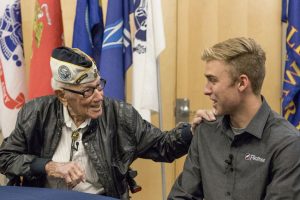
Remembering a day of infamy

On Dec. 7, 1941, Japanese forces surprise attacked the U.S. naval base, Pearl Harbor. The bombing run managed to destroy or damage 20 American naval vessels and over 300 airplanes. Over 2,400 Americans, both military personnel and civilians, died as a result with another 1,000 wounded.
The day after the raid, President Franklin D. Roosevelt labeled the invasion “a date which will live in infamy” and requested Congress declare war on Japan. The attack on Pearl Harbor led America into WWII as a part of the Allied powers and helped defeat the Axis powers, Germany, Italy and Japan.
Now, 76 years later, very few Pearl Harbor survivors are left to tell their stories. Three survivors of the attack attended the annual Pearl Harbor Remembrance Day ceremony at the Clovis Veterans Memorial District the morning of Thursday, Dec. 7.
The honored guests were Charles Lishman of Coarsegold, George Vandersluis and Joe Quercia of Fresno. Quercia explains where he was the when the Japanese raided Pearl Harbor.
We came back in through the harbor and the oil was burning and the battleships were burning and the guys were floating around in that oil. If anybody wanted to cry, now would be the time. You couldn’t do one stinkin’ thing except see all these dead guys floating, it was such a bad scene. Those guys didn’t stand a chance. Here we are, just in the navy, and they were already dead. — Charles Lishman, Pearl Harbor survivor
“When the Japs came, I didn’t believe it,” Quercia said. “I was looking out the porthole with my buddy I shipped in with and I said, ‘Gee, Louis, they’re having gunnery practice on Ford Island. The planes have red spots on them.’ I didn’t know what they were but the announcer on the ship said, “This is war, the Japanese have invaded Pearl Harbor.’ And I thought, what in God’s world?”
Thankfully, Quercia survived the attack and continued on in the War. Initially, he worked as a watertender, but eventually earned the rank of chief petty officer.

“I was in the Battle of the Philippines and we did a lot of escorting, bringing a lot of supplies in,” Quercia said. “I got put on a Destroyer Escort (DE) and they were always bringing stuff into the war zones so we were involved with the Philippine campaign. I didn’t like that very good because we’d go up the little channels and the little PT boats would be with us just in case. We had a little light burning on the back of our DE and they would follow us because we had radar and all that stuff.
“But I was in the complete campaign, from the start to the end along with the Pearl Harbor deal,” Quercia continued. “I gave them six good years. I went in at 18 and came out when I was 24. When I was chief petty officer, my chief engineer begged me to stay. ‘Stay, Joe,’ he said, ‘you’ve got it made and you make good money.’ I said, ‘Yeah, but I’m not with my wife and the ocean is big.’”
Charles Lishman was also a watertender at the time of Pearl Harbor. He recalls the events of the invasion.
“You ever think about what would have happened if this country would’ve been taken over by the Japanese and the Germans?” Lishman questioned. “We had four-inch guns, which when you pull the trigger it goes ‘doink!’ and they don’t even shoot far enough. We went out that channel after the bombing on the USS Perry Destroyer and they put me up in the crow’s nest and I was looking, but I don’t know what I was looking for.
<span data-mce-type=”bookmark” style=”display: inline-block; width: 0px; overflow: hidden; line-height: 0;” class=”mce_SELRES_start”></span>
“Later I found out we were looking for submarines,” Lishman continued. “We came back in through the harbor and the oil was burning and the battleships were burning and the guys were floating around in that oil. If anybody wanted to cry, now would be the time. You couldn’t do one stinkin’ thing except see all these dead guys floating, it was such a bad scene. Those guys didn’t stand a chance. Here we are, just in the navy, and they were already dead.”
Lishman’s enlistment ended Dec. 2, 1941, and was due to return home Dec. 8. Unfortunately, that was about to change. Lishman was not able to return to his wife, Dorothy, when expected. Today, the couple has remained married for 76 and a half years. Dorothy explains her feelings concerning the attack.

“We didn’t have telephones and email and all of that,” Dorothy said. “After Pearl Harbor, it was several weeks before I got a postcard that they gave them to fill out that they were O.K. because we didn’t know for several weeks. Luckily, I had an aunt that worked in Washington D.C. and she checked and found out that Chuck was alive.”
The event ran through several remembrance ceremonies led by various esteemed military members. Paul Loeffler interviewed the three Pearl Harbor survivors and the ceremony concluded with the playing of Taps.
For more related articles by Rurik, check out Japanese-American internment survivor recalls life during WWII, Yamaguchi reflects on time spent in Japanese relocation camps and Haw provides different angle on Executive Order 9066.
For more WWII articles, read WWII veteran George Poplin shares story, inspires others. Check out Paul Loeffler’s radio series, Hometown Heroes.
This author can be reached via twitter @alexrurik23 and via email: Alexander Rurik.